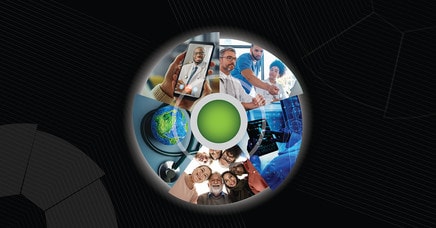2023 Global Life Sciences Outlook has been saved

Analysis
2023 Global Life Sciences Outlook
Innovating and collaborating for tomorrow
The COVID-19 pandemic magnified the importance of digital advances as companies raced to meet the demand for new testing, vaccines, and treatments to combat the pandemic. However, with increased competition, a shifting regulatory landscape, and growing demands from patients and health care providers, life sciences companies face significant challenges and must find ways to differentiate themselves and remain competitive.
Our 2023 global life sciences outlook explores seven trends that are expected to shape the sector. In the coming year, the focus will remain on embracing digital technologies, navigating a changing regulatory landscape and market volatility, and addressing health inequities. By adopting the right strategies and capabilities, life sciences companies can continue to deliver value to patients, health care providers, and other stakeholders.
Elevating health equity
The outlook:
Some inequities in the health system include unconscious bias, lack of trust, and language barriers—all of which are impediments to preventive therapies and devices developed to reach people who really need them. These inequities may also come at a substantial cost in annual lost productivity for life sciences companies. Strategies are needed that place health equity at the heart of life sciences companies’ business operations and extend across their organizations, offerings, communities, and ecosystems.
Deloitte Health Equity Institutes partnered with the World Economic Forum (WEF) to develop the Global Health Equity Network (GHEN) to ensure health equity across businesses. As a part of this effort, Deloitte and 38 other organizations signed the GHEN Zero Health Gaps Pledge to adopt a multidisciplinary approach to support diversity, equity, and inclusion (DEI) programs; provide accessible and quality health services; pay employees a fair wage; and invest in safe living environments.
Key takeaways:
- Through diversified clinical trials, patients can have equitable access to treatments that break down inequality barriers. However, a lack of awareness and trust in organizations can impede trial diversity. To overcome these barriers and encourage greater participation from underserved communities, companies must provide reliable information from trusted sources within those communities.
- To achieve health equity, leaders need to take steps to eliminate racism and other discriminatory biases rooted within the system. This would help life sciences organizations deliver quality services without disparities, attract and retain the best talent, and elevate brand reputation.
- Companies can promote health equity by developing strategies that focus on being intentional about serving patients without biases, forming alliances among stakeholders to work toward addressing the root causes of health inequities, tailoring products for diverse needs, promoting awareness, and building trust.
Supply chain again a CEO agenda
The outlook:
Historically, supply chain management has relied on static assumptions to create forecasts using scenarios from similar circumstances. However, in the event of unforeseen emergencies such as a significant disruption in distribution channels, these forecasts might not be adequate.
With volatility related to the global pandemic, shipping and logistics-related geopolitical turmoil, and a 40-year-high inflation, the global life sciences sector is witnessing a shift in perspective toward supply chains. The new approach aims to increase flexibility, streamline manufacturing processes, and enhance real-time tracking. According to a Fortune/Deloitte survey, 88% of respondents cited production or logistics issues and reduced logistics capacity as key challenges. To mitigate these challenges, life sciences companies are adopting transformative solutions to enable proactive scenario planning and risk mitigation.
Key takeaways:
- The lack of visibility into thousands of suppliers and their own supply chains is one of the barriers to adoption of a highly connected, agile supply network. As a result, life sciences companies are prioritizing digital governance to prevent delays, such as supply chain bottlenecks, with the use of smart sensors that provide timely feedback on operations.
- The estimated market for pharmaceutical drug delivery is expected to grow from U$1.17 trillion in 2022 to U$1.45 trillion by 2028. The impact of this massive network is likely to be seen as an environmental adversity over the long term. Industry-wide efforts are also underway to improve supply chain sustainability and transparency.
- Geopolitical threats such as trade wars, cyber risks, and inflation have led to greater interdependence of supply chains and increased their role in national security. In response, many life sciences companies are adopting the use of blockchain technology for anti-counterfeiting, genomics, clinical data sharing, revenue management, and materials transfer.
Patient centricity
The outlook:
Since the pandemic, three-fourths of people globally now have experience with at-home tests, and companies are increasingly able to access, interpret, and act on the billions of patient data points.
With more than 435,000 active clinical trials underway across the globe, and more than 2 million devices across more than 7,000 groups of instruments, machines, and software used for medical purposes, companies can generate insights that will help life sciences enterprises move toward patient-centricity. This involves deployment of decentralized diagnostics and direct-to-consumer (DTC) channels and solutions, gathering real-world patient information, and achieving optimal patient outcomes through digital alliances.
Key takeaways:
- Life sciences companies can now collect real-time patient data away from centralized care sites using personal devices. With the rise in patient-centricity, many life sciences companies are exploring DTC channels enabling direct patient engagement when and where patients seek it.
- Companies are using wearable devices to gain real-time data in a more patient-friendly way. This, combined with developing new methods of utilizing big data, will lead to creation of high-precision pharmaceuticals and medical care tailored to individual patients.
- Digital partnerships will aid life sciences companies’ processes and organize the output of data collected across diverse locations helping to enhance their patient-centric offerings.
- Connected devices that provide prescription-based digital therapeutics are helping to enhance patient-centricity by promoting medication adherence and signaling potential safety concerns.
Research and development
The outlook:
According to a recent Deloitte survey, research and development (R&D) innovation is one of the top actions that 91% of life sciences organizations plan to invest in during 2023, and almost half are optimistic about the sector’s outlook in the coming year. Despite that, there are significant financial challenges facing the success of the current high-risk, high-cost R&D model. To move past this, and to succeed in the post-pandemic world, life sciences R&D organizations need to focus on accelerating digital transformation programs, strategic shifts, and commercial reorganization.
Key takeaways:
- Real-world evidence (RWE) helps life sciences organizations better understand disease progression, monitor patient safety, and assess clinical and cost effectiveness. During the pandemic, RWE enabled the sector to innovate faster by predicting global hot spots, collect better data from diverse racial and ethnic groups, and understand vaccine effectiveness across age, gender, race, and ethnicity.
- Life sciences companies are using artificial intelligence (AI) to transform drug discovery by extracting concepts and relationships from data. By 2030, the time required for screening to preclinical testing will be reduced to a few months, and new potential drug candidates could be identified at more affordable prices.
- Regulators globally are working closely with stakeholders to create clusters of technical experts, share search results, leverage inspection reports, and propagate information. Collaboration within the industry has also increased with biopharma companies and medtech manufacturers sharing data and resources to accelerate development of vaccines and treatments.
Digital transformation
The outlook:
The pandemic led many life sciences companies to digitize their operations virtually overnight. Cloud technologies and platforms enabled organizations to let their employees work remotely and collaborate, share data across third-party networks, and run AI and machine learning (ML) algorithms—all while reducing costs, improving time-to-discovery and insight, and collecting data to improve manufacturing and supply chain operations.
The pandemic accelerated the application of digital solutions such as software as a service, AI, Internet of Things, automation, blockchain, data lakes, wearables, augmented reality/virtual reality, and digital therapeutics.
Key takeaways:
- The advantages that made digital transformation lucrative can also lead to vulnerabilities in companies’ data systems. In the past few years, the cyberattacks on biopharma and medtech companies have disrupted supply chain and manufacturing processes, resulting in millions of dollars in damages. In such a scenario, garnering end-user trust becomes crucial for these companies.
- A Deloitte survey found that only 20% of biopharma companies are digitally maturing. Companies need to focus on solutions that are delivering value while enabling them to deliver improved health, wellness, and experiences for their patients; drive business impact; and inspire employees and stakeholders.
- For life sciences companies to achieve digital transformation and maturity, the leaders need to address the five key questions surrounding companies’ digital ambition, ways to broaden digital transformation, realizing digital value, etc.
Pricing and reimbursement
The outlook:
Historic global shifts, pharmaceutical reimbursement policies, and intensifying competition have led life sciences companies to adapt using dynamic pricing techniques where prices fluctuate based on real-time data such as customer demand. Pharmaceutical companies are also working to understanding niche diseases through hyper-targeting of patient populations to ensure equitable access to treatments.
Key takeaways:
- Life sciences companies are facing significant pricing changes under the Inflation Reduction Act in the United States, which empowers Medicare to negotiate drug prices and compels drugmakers to pay inflationary rebates. To comply with the changing landscape, pharmaceutical companies will be required to evaluate the economic consequences, conduct negotiations with government agencies, and adjust customer agreements.
- To improve clinical value, pricing, and reimbursement, life sciences companies will have to tailor decisions to regional markets. Also, they will have to focus on marketing specialized, next-generation therapies in order to develop medicines for niche diseases affecting a small patient population.
- Life sciences companies face potential legal hurdles and reputational risks while trying to increase drug access. Pharmaceutical companies need to keep up with the upcoming laws surrounding pricing transparency and equitable access. Technological advancements are likely to prove beneficial in adopting a truly value-based approach.

Evolving portfolios and value creation
The outlook:
Although there has been a downturn in mergers and acquisitions (M&A) activities over the past decade, life sciences companies are poised to witness an increase in M&A values in 2023 due to increased competition and the growing demand for multi-indication pharmaceutical products.
Vaccines and next-generation treatments, such as cell gene therapy, represent new streams of revenue for life sciences companies. Meanwhile, medtech companies are expected to divest noncore assets in order to improve their growth profiles and create opportunities for strategic acquirers.
Key takeaways:
- M&A has proven to be a lucrative option for life sciences companies looking to facilitate business transformation, create ecosystem value, and disrupt the industry. In 2023, a potential uptick in the value of M&A deals is expected. One area of potential interest for acquirers is multi-indication pharma, which refers to drugs that can treat several diseases that are linked to similar causes.
- The emergence of mRNA technology has invigorated pharmaceutical portfolios, and the outlook for mRNA vaccines includes ongoing research to develop vaccines against diseases such as HIV, Zika, and rabies, which are currently in the human trial phase.
- Next-generation therapies, including gene editing, have proven to be a crucial area for portfolio expansion among life sciences companies. Moreover, companies are divesting assets that do not fit within their overall portfolios, restructuring and rebalancing their portfolios to achieve the right balance for sustainable and profitable growth.
Recommendations
2023 Outlook for life sciences: Inflation, talent, AI are top issues for biopharma and medtech
2023 will be challenging and transformative for life sciences companies.







